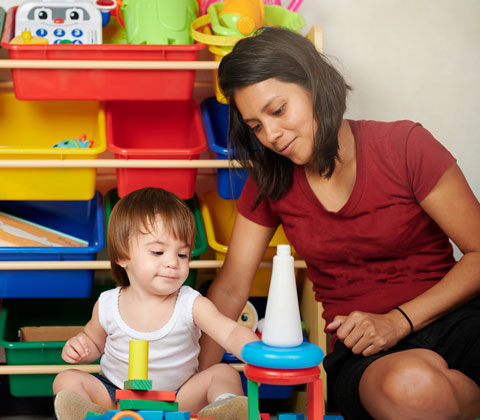Like most families, families of children with disabilities use a variety of early care and education programs such as center- or home-based childcare to meet their needs and provide valuable and inclusive learning experiences for their children. This provides rich experiences for childcare professionals, early interventionists, and special educators to work closely together. To learn more about inclusion, see the U.S. Departments of Education and Health and Human Services paper on Inclusion of Children with Disabilities in Early Childhood Programs.
However, families and professionals often struggle to collaborate with each other and meaningfully include children with disabilities in early care and education programs. In this blog, we offer strategies for building better relationships among professionals so infants and toddlers with disabilities can learn in natural environments, within daily routines, and with familiar people and materials.
Definitions
Because some readers of this blog may be unfamiliar with this topic, let’s start with a few important definitions to set the stage:
- Early care and education: Public, private, or community-based programs for young children birth to age 5, including center- and home-based childcare, Early Head Start, Head Start, and faith- or university-based programs.
- Early intervention (EI): Services for children with disabilities and developmental delays between birth and age 3 and their families. These often include speech and language pathology, physical therapy, behavior services, or other services. These services are provided by Part C of the Individuals With Disabilities Education Act (IDEA).
- Individual Family Service Plans (IFSP): Plans or documents that describe the child’s current development, goals or outcomes for the next year, and strategies and services to help children and families achieve those goals.
- Early intervention visits: Visits by EI professionals (e.g., developmental therapist, speech-language pathologist) to a family home, childcare program, or other community locations to provide services that support the child and family’s IFSP. During these visits, EI professionals coach caregivers, including family members and childcare providers, to help children learn and grow.
To see what EI in childcare can look like, see Natural Partners in Natural Environments.
Relationships and communication between childcare and EI professionals
Now that we’ve taken some time to go over definitions, let’s consider how all of these components fit together.
Most often childcare professionals, particularly in center-based programs, are not invited to IFSP meetings and planning for EI visits. Therefore, both childcare and EI professionals may be unsure how to work with each other in early care and education programs. For this reason, professionals often see EI visits as chaotic or distracting. Although communication is the key to successful collaboration and teaming, meaningful conversations should be scheduled outside of EI visit times because childcare professionals must address the immediate needs of their program. So, when a family decides that EI visits will happen at an early care and education program, consider the following ideas:
- The IFSP team can invite childcare professionals to IFSP meetings.
- Early care and education professionals can schedule meetings with the EI professionals before visits to discuss what EI can look like, what routines will be happening during the visit, and how childcare professionals can be involved.
- EI professionals can observe the program before beginning EI visits to better understand the program’s philosophy, routines, and staff schedules.
- All professionals should understand and follow the confidentiality and information-sharing procedures for their program and state.
Using EI in childcare routines and activities
Because children learn best through daily routines and with familiar people, it is beneficial for childcare professionals to understand effective strategies for children receiving EI so they can use them throughout the days and weeks in between EI visits. Avoid doing EI visits in a separate room or area of the early care and education program so that EI visits are more functional for the children and strategies are practiced in the natural environment, during daily routines, and alongside peers. Consider these ideas:
- EI professionals can model and describe strategies with childcare professionals and invite them to practice them during EI visits.
- Childcare professionals can share with EI professionals what other routines and materials are available throughout the day that they think would be easy or challenging to use with these strategies.
- Childcare professionals can share and model strategies with families who may not be able to attend EI visits.
In conclusion, EI visits to early care and education programs are not only possible but a common experience for children, families, and professionals. These visits present a valuable opportunity for infants and toddlers with disabilities to develop and learn through meaningful daily experiences. Creative collaboration among childcare and EI professionals can greatly impact outcomes for not only children and families but also professionals.

Jenna Weglarz-Ward
Jenna Weglarz-Ward has been assistant professor in the Department of Early Childhood, Multilingual, and Special Education at the University of Nevada, Las Vegas specializing in early childhood education/special education since completing her Ph.D. at University of Illinois in 2016. Her research focuses on the inclusion of young children with disabilities in childcare settings by strengthening family partnerships and professional development.
Biography current as of 2021
IEL Resources
- Resource List: Special Education and Inclusion in Early Care and Education
Web Resources
-
Early Intervention Training Program Resources
Source: Early Intervention Training Program (EITP)
View videos and supplemental materials on the following:
-
Policy Statement: Inclusion of Children with Disabilities in Early Childhood Programs (Nov. 28, 2023)
Source: U.S. Department of Education
This page provides information, resources, and a policy statement on the inclusion of children with disabilities in early childhood settings.


